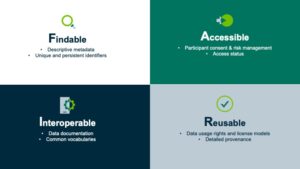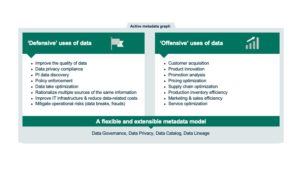With the rapid growth in data volume, sources, as well as complexity, businesses are increasingly adopting the best practices for metadata management to power data governance and maximize data use for analytics, ML, and operational use cases. In this blog, we’ll outline how metadata management frameworks can impact your organization’s data strategy to drive value from data.
What is a metadata management framework?
A metadata management framework is a set of tools to help you capture, integrate, manage and publish rich metadata. The framework includes a repository, access portal, discovery and mapping tools, collaborative features and analytical capabilities to manage your metadata efficiently.
With the right framework, you can quickly implement metadata management and integrate metadata across your organization.
The benefits of a metadata management framework
Metadata is data in the context of “who, what, where, why, when, and how.” Just the way library cards present you with the essential information about a book, the title, author, publisher, ISBN, or genre — metadata delivers the key information associated with a data asset.
Metadata enriches the context of data by describing how data is structured, preserved, connected to other information assets, and used across the organization. Metadata management frameworks make data extremely easy to search and access.
The key benefits of a metadata management framework include:
- Improved search and access: a single portal with role-based views and advanced search filters empowers data citizens to quickly access data across the enterprise
- Comprehensive management of business semantics: business glossaries, synonyms, business terms and relationships between them, rules, custom types and taxonomies
- Interoperability: a shared understanding of data assets with standard vocabularies helps data citizens use data across applications or workflows
- Usage tracking: full visibility into data consumption and access logs
A metadata management framework supports the FAIR principles to improve the Findability, Accessibility, Interoperability, and Reuse of data assets.
The FAIR guiding principles for scientific data management and stewardship

Top features of a metadata management framework
The framework is a set of tools to make data searchable, usable, manageable and support business semantics. It helps data citizens quickly access trusted data and facilitates automated data management for data stewards.
A powerful metadata management framework must be flexible to adopt new technologies, scalable to respond to business demands and customizable to align with the organizational data strategy. The top features of such a framework include:
- Metadata repository to store, manage and publish metadata, as well as perform analysis on metadata
- A flexible and extensible metadata model that enables robust data strategies for enterprises of all shapes and sizes
- Automated metadata discovery, ingestion, modeling and mapping tools to ensure faster discovery and mapping across diverse sources
- Robust search and filter features
- Business glossaries to define business terms along with relationships across them for governance purposes
- Semantic frameworks to support taxonomies and modeling languages
- Rules management to facilitate the automated administration of business rules for effective governance
- ML-powered automation capabilities to add business context to data at scale, including automatically identifying and tagging sensitive data
- Data lineage to track and describe data along the entire data lifecycle
Metadata management frameworks and data strategy
Gartner Research recommends that organizations that use role-based frameworks to organize and process metadata can boost their data processing performance and business intelligence. You will find this as one of the most compelling benefits of a framework, influencing your enterprise data strategy through improved data access and self-service analytics.
While both defensive and offensive data strategies strive to accomplish different objectives, they require the same metadata foundation that needs to be flexible and extensible. To build a mature data culture, organizations must begin with knowing their data, and then contextualize that data, govern it, and make it available for both offensive and defensive use cases.
Metadata model highlighting both defensive and offensive strategies

A metadata management framework empowers you with the agility to integrate new technologies and tackle disruption with confidence. With the right framework and visibility into metadata, you can begin your journey towards Data Intelligence — creating an inventory of enterprise data assets with the pillars of data governance, data privacy, data catalog and data lineage.
The Gartner report on the state of metadata management predicts that the next frontier for metadata management will be turning descriptive metadata into active metadata. In the next blog of this series, we shall focus on how active metadata graphs and machine learning can help build a foundation for Data Intelligence within your organization.




